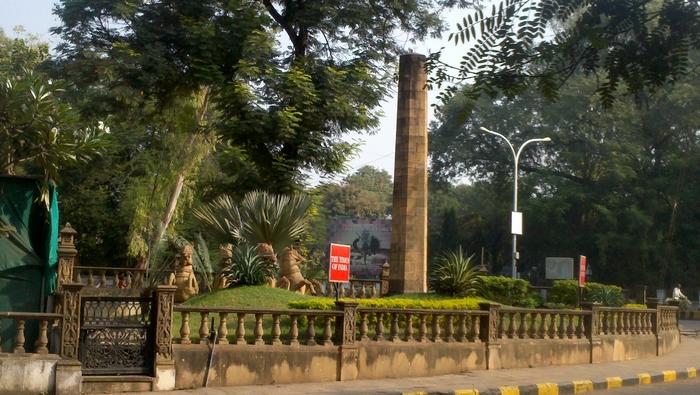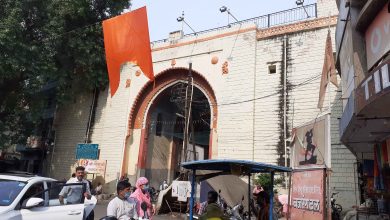Court Rebukes Collector for Inaction on Zero Mile’s Upkeep

Nagpur Collector| Bombay High Court | Zero Milestone Nagpur: Nagpur’s Iconic Zero Milestone Neglected: High Court Takes Action
The Nagpur bench of the Bombay High Court recently delivered a stern rebuke to the district collector for neglecting the maintenance and upkeep of the iconic Zero Milestone in Nagpur. This reprimand highlights the ongoing concerns surrounding the preservation of this historical monument, a symbol of the city’s rich cultural heritage. The court’s strong words came after the collector suggested that the funds for the project could be sourced from the Nagpur Municipal Corporation’s (NMC) Heritage Committee account. The proposal triggered the court’s admonition, emphasizing the collector’s failure to proactively manage the situation.
Understanding the Significance of Zero Milestone
The Historical Importance of Zero Milestone
Zero Milestone in Nagpur is not just a geographical marker; it is a testament to the city’s historical significance. Traditionally, it has been the point from which all distances in India were measured during the British era. Over the years, it has evolved into a symbol of Nagpur’s central role in the country’s geography and history.
Why Preservation Is Crucial
Preserving such monuments is vital for maintaining the cultural and historical integrity of a place. When landmarks like Zero Milestone are neglected, it isn’t just the structure that deteriorates—it’s a part of the city’s identity that is lost. This makes the court’s intervention particularly important, as it underscores the need for vigilant stewardship of our cultural heritage.
The Court’s Intervention: A Critical Turning Point
The High Court’s Reprimand
On Thursday, the Nagpur bench of the Bombay High Court, consisting of Justices Nitin Sambre and Abhay Mantri, reprimanded the district collector for shirking his responsibility towards the upkeep of Zero Milestone. The court criticized the collector’s suggestion to use funds from the NMC Heritage Committee, implying a lack of initiative on the part of the administration.
Mandate to Submit Recommendations
The court has instructed the collector to submit his recommendations regarding the maintenance of Zero Milestone through an affidavit by August 13. This directive signals the court’s intent to ensure accountability and to see concrete actions taken towards the monument’s preservation.
Public Interest Litigation: A Call for Accountability
Suo Motu PIL and Its Implications
The High Court’s involvement comes as part of a suo motu Public Interest Litigation (PIL), which was initiated due to the neglect that has led to the deterioration of Zero Milestone. The PIL underscores the importance of the monument and the collective responsibility of government bodies to preserve such landmarks.
Role of the Amicus Curiae
Kartik Shukul, appointed as amicus curiae, plays a crucial role in this litigation. His appointment is a clear indication of the seriousness with which the court is treating this issue. The amicus curiae’s involvement ensures that an impartial perspective is brought to the case, facilitating a fair and just resolution.
Nagpur Municipal Corporation’s Role in Preservation
Funding Challenges and Heritage Committee’s Involvement
The proposal to use funds from the NMC Heritage Committee raises important questions about the allocation of resources for heritage preservation. The Heritage Committee’s funds are derived from a 2% cess levied on building plan approvals by the NMC and Nagpur Improvement Trust (NIT). This cess is intended to support the maintenance of heritage sites, including Zero Milestone.
Collector’s Proposal Under Scrutiny
The collector’s suggestion to tap into these funds indicates a reactive approach rather than a proactive one. The court’s response reflects its dissatisfaction with this approach, highlighting the need for more comprehensive and forward-thinking planning in heritage preservation.
The Broader Implications for Heritage Preservation
Neglect of Heritage Sites: A National Issue
The situation with Zero Milestone is emblematic of a broader issue facing many heritage sites across India. Neglect and insufficient maintenance of such sites lead to the gradual erosion of the country’s cultural fabric. This case serves as a wake-up call for authorities nationwide to prioritize heritage preservation.
Legal Framework and Preservation Efforts
India has a robust legal framework for the protection of heritage sites, but implementation often falls short. The Antiquities and Art Treasures Act, 1972, and the Ancient Monuments and Archaeological Sites and Remains Act, 1958, provide a legal foundation for preservation efforts. However, the enforcement of these laws is often inconsistent, leading to the neglect seen in cases like Zero Milestone.
The Importance of Public Awareness and Involvement
Community Engagement in Preservation
One of the key takeaways from this case is the importance of public awareness and community involvement in heritage preservation. When the public is engaged and informed, there is greater accountability, and the chances of preserving historical sites increase.
Educational Initiatives
Educational initiatives aimed at increasing awareness about the significance of heritage sites like Zero Milestone can play a critical role in their preservation. Schools, colleges, and community groups should be encouraged to take an active interest in local heritage, fostering a sense of pride and responsibility.
Steps Forward: Ensuring the Preservation of Zero Milestone
Strategic Planning for Maintenance
Going forward, it is crucial that authorities develop a strategic plan for the maintenance and preservation of Zero Milestone. This plan should include regular maintenance schedules, appropriate allocation of funds, and clear lines of responsibility among different government bodies.
Collaboration Between Government Bodies
Effective preservation of heritage sites requires collaboration between various government bodies, including the NMC, NIT, and the district administration. Clear communication and cooperation are essential to ensuring that preservation efforts are well-coordinated and effective.
Innovative Approaches to Preservation
Innovative approaches, such as the use of modern technology for monitoring and maintaining heritage sites, should be explored. For example, 3D scanning and digital archiving can help in the restoration of deteriorated parts of the monument, ensuring that its historical integrity is preserved.
The Role of Judiciary in Heritage Preservation
Judicial Activism in Heritage Protection
The judiciary plays a vital role in the protection of heritage sites. Cases like this one demonstrate the power of judicial activism in holding authorities accountable and ensuring that they fulfill their responsibilities towards heritage preservation.
Precedents Set by the High Court
The Nagpur bench of the Bombay High Court has set a precedent with its firm stance on the Zero Milestone issue. This case may serve as a reference for future legal actions concerning the neglect of heritage sites across the country.
The rebuke from the Nagpur bench of the Bombay High Court to the district collector regarding the upkeep of Zero Milestone is a significant moment in the ongoing struggle to preserve India’s cultural heritage. This case highlights the importance of proactive management, accountability, and public involvement in the preservation of historical sites. As the court continues to monitor the situation, it is imperative that all stakeholders, including government bodies, the judiciary, and the public, work together to ensure that Zero Milestone and other heritage sites are preserved for future generations.
1. What is the historical significance of Zero Milestone?
Zero Milestone in Nagpur is a historical landmark from which all distances in India were measured during the British era. It symbolizes Nagpur’s central role in India’s geography.
2. Why did the High Court reprimand the district collector?
The High Court reprimanded the collector for neglecting the maintenance of Zero Milestone and for suggesting that the funds for its upkeep be sourced from the NMC Heritage Committee, indicating a lack of proactive management.
3. What is a suo motu Public Interest Litigation (PIL)?
A suo motu PIL is a legal action initiated by a court on its own accord, without a formal complaint, usually in the interest of the public or to address a significant issue.
4. How does the NMC Heritage Committee fund heritage preservation?
The NMC Heritage Committee is funded by a 2% cess levied on building plan approvals, which is intended for the maintenance and preservation of heritage sites in Nagpur.
5. What steps can be taken to improve the preservation of heritage sites?
Improving preservation efforts requires strategic planning, collaboration between government bodies, innovative approaches like digital archiving, and active public involvement.









